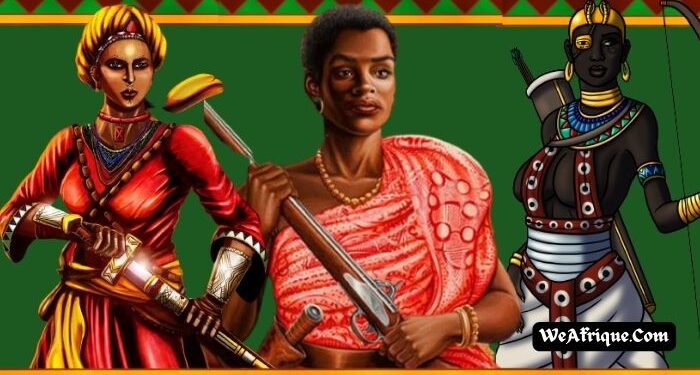In recent times, African females have been placed in the context of the family as marriage, reproduction, and nurture are assumed to be their ultimate goals; a perspective advocated by gender essentialists. The conventional norm is that the masculine gender is the provider and protector.
Consequently, this has somewhat placed her in the shadows of a man and crippled her ability to make vital contributions to political development and freedom chase, especially in patriarchally rigid societies.
However, historical accounts of precolonial African societies recall the feats of female warriors like Queen Amanirenas, Queen Amina, and the Dahomey Amazons who ruled empires and led men to war.
Here are 7 African Female Warriors You Should Know
7. Queen Ranavalona of Madagascar (1883 -1897)
Queen Ranavalona was adopted into the royal family as a reward for her father’s service to the royal house. She later became the queen after the king’s son, Radama made her his first wife. Howbeit, following the death of the king, Ranavolona ascended the throne after killing all potential successors.
She ruled Madagascar for 33 years in a reign that was deemed fierce and brutal, especially to the Christians who were stripped of their rights to worship. Nonetheless, her resistance to the European forces and movement remains commendable.
6. Queen Nanny (1728-1734)
Widely accepted as a native of Asante present-day Ghana, Nanny was kidnapped in her early years and forced into slavery in Jamaica. Following her escape, she became the leader of the Windward Maroons in Jamaican Blue Mountain in the early 18th century. History recalls the maroons as enslaved Africans who spent many years fighting for their freedom.
Nanny became their voice and also formed a formidable force that would fight the guerrilla war against the British and this became the first Marroon war.
The war lasted for many years until the British were outnumbered and weakened. At the very last of it, they sued for peace and a treaty was signed on April 20, 1740. This date is still observed as a national holiday for the people.
Nanny and her followers were also given several acres of land and also granted freedom that lasted for many years.
She is the only national female hero in Jamaica who is remembered to this day as an image of hope, and resilience.
5. Yaa Asantewaa (mid 1800s -1921)
She was appointed the Queen mother by her brother Kwasi Afrane, the King of Edwesu. More than being the King’s adviser, Yaa Asantewaa was the Custodian of the Golden Stool of the Asante Kingdom which is part of modern Ghana.
After the King of Ashante was captured and exiled by the British, the Ashante nation became divided and considered surrendering their allegiance to the British Governor Sir Frederick Hodgson who also requested the Golden Stool. It was at this moment that Yaa Asantewaa took on her fighting shoes.
She challenged the chiefs of Asante and reminded them of the ancient chiefs like Osei Tutu, Okomfo Anokye, and Opoku who would lay down their lives than surrender to the White men. The queen mother further dared to lead women to war if the men had lost hope in Asante which of course she did.
She led over 5000 armies against the British for the fifth and final Anglo-Ashanti war which is considered the most brutal war and remembered as the Yaa Ashanti war. Though her armies were outnumbered and she was finally captured, she is remembered in present-day Ghana as a patriotic, brave, and courageous female warrior.
Read Also: 5 Greatest African Empires And How They Fell
4. Queen Nzinga Mbandi
Nzinga became the queen of the Matamba and Ndongo Kingdoms after her brother committed suicide in 1624. Though her reign as queen was initially resisted in line with the tradition of Mbundu against female rulers, her diplomatic tactics saw her take the throne and rule for 4 decades.
Prior to this time, the Portuguese and Ndongo kingdom had settled their differences over a peace talk conference. In fact, Nzinga solidified their relationship by converting to Christianity, adopting a new name ‘Ann’, and the Portuguese title ‘Dona’. Nonetheless, following her ascension to the throne, the Portuguese ate back their words and declared war.
Consequently, Nzinga fled from her kingdom alongside her people. They headed for the Kingdom of Matamba which they attacked capturing their queen and routing their armies. Nzinga’s victory over the Matamba made her their new leader.
Following this, she formed a great force including runaway slaves, defecting soldiers, and women that would fight a trench war against the Portuguese which lasted for 30 years. Within these years, Nzinga formed an alliance with the Dutch and acquired over 50 Dutch elite soldiers armed with rifles.
She emerged victorious in 1644, 1646, and 1647 until Dutch armies were defeated and had to move out of the region in 1648. Nonetheless, she continued fighting with her people until 1657 when she signed a peace treaty with Portugal. Nzinga spent her last days rebuilding her land until she died in 1663 at the age of 81.
3. Queen Amina of Zazzau (1576 AD)
The “warrior queen” as many have named her was the queen of Zazzau in the present Zaira, Nigeria. She is said to have ruled her people for 35 years between 1576 and 1610 after the death of her brother.
During her reign, she led men to war and fought many battles which were mostly victorious. Through this, she expanded Zazzau to Idah, Nupe, and Kano. She also built walls around the territories she conquered which still stand until this day.
Asides from her fighting prowess, Amina also fostered the growth of trade and commerce by creating trade routes across western Sudan, Egypt, and Mali.
2. Ahosi (The Dahomey Amazons 1600s -1904)
Before Dahomey’s kingdom became a French protectorate, the ancient kingdom was protected by females who led the armed forces and were known as the Ahosi or The Dahomey Amazons.
These women fought many wars including the fight against the Europeans. Unfortunately, they slowly declined in number after the first and second Franco-Dahomean wars leading to their disbandment. It is said that only 17 out of 430 Amazons came back alive.
Nonetheless, several depictions of their stories have been reflected by African society including the television series Xena and The Woman King historical film.
1. Queen Amanirenas (60 BC)
Known as the ‘one-eyed Queen’, Amanirenas was known as the Queen of Kush in present-day Sudan and history remembers her as one of the greatest queens to have ever existed.
Amanirenas reign was accompanied by a series of wars that charged her as a fierce queen and warrior. She became a great force after leading about 30,000 Kushite armies to a battle against the Roman empire which was led by Caesar Augustus. Though stories of Augustus’ victory across Eygpt were spine-breaking, Amanirenas made her marks on the battlefront.
Following her victory, she got a major statue of the Roman Emperor Augustus destroyed and further mocked him by burying the statue’s head at the entrance of her royal palace.
While many account report that the Emperor signed a peace treaty, we can assert that he fully surrendered to the one-eyed queen and accepted all her demands including withdrawal from the Kushite territories.





















Discussion about this post